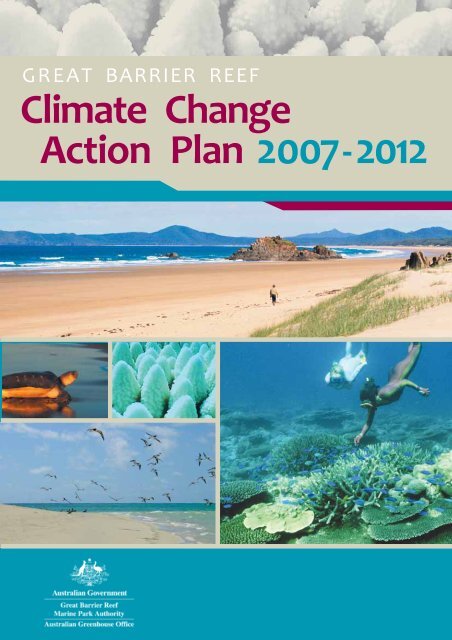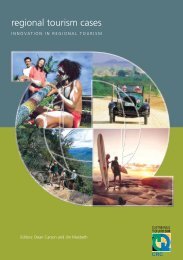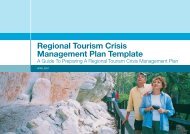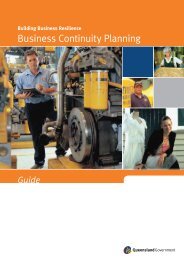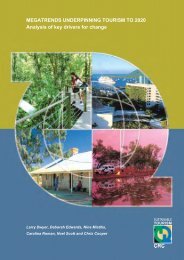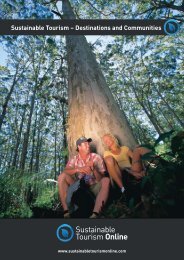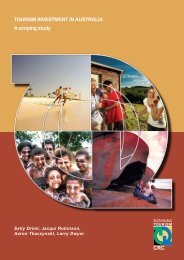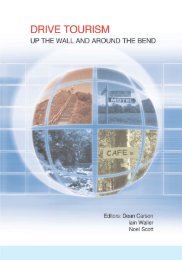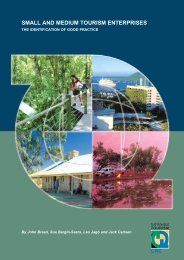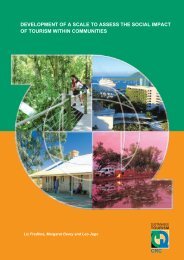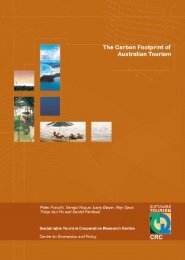Climate Change Action Plan - Great Barrier Reef Marine Park Authority
Climate Change Action Plan - Great Barrier Reef Marine Park Authority
Climate Change Action Plan - Great Barrier Reef Marine Park Authority
You also want an ePaper? Increase the reach of your titles
YUMPU automatically turns print PDFs into web optimized ePapers that Google loves.
GREAT BARRIER REEF<br />
<strong>Climate</strong> <strong>Change</strong><br />
<strong>Action</strong> <strong>Plan</strong><br />
2007 2012
GREAT BARRIER REEF<br />
<strong>Climate</strong> <strong>Change</strong><br />
<strong>Action</strong> <strong>Plan</strong><br />
2007 2012
This publication has been made possible in part by funding from the Australian Greenhouse Office, in<br />
the Department of the Environment and Water Resources.<br />
Published by:<br />
<strong>Great</strong> <strong>Barrier</strong> <strong>Reef</strong> <strong>Marine</strong> <strong>Park</strong> <strong>Authority</strong>, Townsville, Australia<br />
Copyright: © Commonwealth of Australia 2007<br />
Reproduction of this publication for educational or other non-commercial purposes is authorised<br />
without prior written permission from the copyright holder provided the source is fully acknowledged.<br />
Reproduction of this publication for resale or other commercial purposes is prohibited without prior<br />
written permission of the copyright holder.<br />
<strong>Great</strong> <strong>Barrier</strong> <strong>Reef</strong> <strong>Marine</strong> <strong>Park</strong> <strong>Authority</strong>.<br />
<strong>Great</strong> <strong>Barrier</strong> <strong>Reef</strong> climate change action plan 2007-2012.<br />
ISBN 9781876945626 (web).<br />
1. Global warming. 2. Climatic changes. 3. Greenhouse<br />
gases. 4. <strong>Great</strong> <strong>Barrier</strong> <strong>Reef</strong> <strong>Marine</strong> <strong>Park</strong> (Qld.). I. Title.<br />
363.7387<br />
Layout: RTM Design<br />
Please cite this publication as:<br />
<strong>Great</strong> <strong>Barrier</strong> <strong>Reef</strong> <strong>Marine</strong> <strong>Park</strong> <strong>Authority</strong> (2007) <strong>Great</strong> <strong>Barrier</strong> <strong>Reef</strong> <strong>Climate</strong> <strong>Change</strong> <strong>Action</strong> <strong>Plan</strong><br />
2007 – 2011<br />
Available from: <strong>Great</strong> <strong>Barrier</strong> <strong>Reef</strong> <strong>Marine</strong> <strong>Park</strong> <strong>Authority</strong><br />
2–68 Flinders St, PO Box 1379, Townsville, Qld 4810, Australia<br />
Tel: +61 7 4750 0700, Fax: +61 7 4772 6093<br />
Email: info@gbrmpa.gov.au<br />
Also available from the web: http://www.gbrmpa.gov.au/<br />
This is a climate neutral publication. All greenhouse gases generated in the<br />
production have been offset by funding clean energy projects.<br />
Visit www.climatefriendly.com for further information
Contents<br />
Minister’s Foreword …………………………………......................................................................................…………… 2<br />
Background ………………………………………...............................................................................................…………… 3<br />
Objective 1: Targeted Science …………….....................................................................................………………… 6<br />
Objective 2: A Resilient <strong>Great</strong> <strong>Barrier</strong> <strong>Reef</strong> Ecosystem ……................................................…………….. 7<br />
Objective 3: Adaption of Industries & Communities …............................................................................… 8<br />
Objective 4: Reduced <strong>Climate</strong> Footprints ………………................................................................................… 9<br />
Further Information …………………………….............................................................................................……………10<br />
<strong>Great</strong> <strong>Barrier</strong> <strong>Reef</strong> <strong>Climate</strong> <strong>Change</strong> <strong>Action</strong> <strong>Plan</strong> 2007–2012<br />
1
Minister s Foreword<br />
The <strong>Great</strong> <strong>Barrier</strong> <strong>Reef</strong> holds a very special place in the hearts and minds of Australians and its<br />
international significance is enshrined in its status as a World Heritage Area. It supports a wealth of<br />
recreational opportunities, thousands of jobs, and industries worth $6.9 billion dollars annually.<br />
However, coral reefs are highly vulnerable to the effects of climate change, and the <strong>Great</strong> <strong>Barrier</strong><br />
<strong>Reef</strong> is not immune from this threat.<br />
The Australian Government is already recognised internationally as a leader in protecting coral reefs<br />
from the impacts of climate change. Current strategies to maintain and restore resilience to the <strong>Great</strong><br />
<strong>Barrier</strong> <strong>Reef</strong> include the Zoning <strong>Plan</strong> and the <strong>Reef</strong> Water Quality Protection <strong>Plan</strong>. The <strong>Great</strong> <strong>Barrier</strong><br />
<strong>Reef</strong> <strong>Climate</strong> <strong>Change</strong> <strong>Action</strong> <strong>Plan</strong> establishes a program of practical actions that will complement<br />
these internationally lauded measures and build the long-term resilience of the <strong>Great</strong> <strong>Barrier</strong> <strong>Reef</strong> to<br />
climate change.<br />
The book <strong>Climate</strong> change and the <strong>Great</strong> <strong>Barrier</strong> <strong>Reef</strong>: A Vulnerability Assessment, provides the<br />
foundation for the <strong>Great</strong> <strong>Barrier</strong> <strong>Reef</strong> <strong>Climate</strong> <strong>Change</strong> <strong>Action</strong> <strong>Plan</strong>. This <strong>Action</strong> <strong>Plan</strong> identifies specific<br />
measures to enhance resilience of the <strong>Great</strong> <strong>Barrier</strong> <strong>Reef</strong> ecosystem and support adaptation by<br />
regional communities and industries that depend on it.<br />
The Government has allocated almost $9 million over the next five years to implement the <strong>Action</strong><br />
<strong>Plan</strong>. This is in addition to a considerable investment in research through the <strong>Marine</strong> and Tropical<br />
Science Research Facility and day-to-day management of the <strong>Great</strong> <strong>Barrier</strong> <strong>Reef</strong> <strong>Marine</strong> <strong>Park</strong>.<br />
Through these efforts, the Australian Government will help sustain the values that make the <strong>Great</strong><br />
<strong>Barrier</strong> <strong>Reef</strong> special.<br />
The Hon Malcolm Turnbull MP<br />
Minister for the Environment and Water Resources<br />
2 <strong>Great</strong> <strong>Barrier</strong> <strong>Reef</strong> <strong>Climate</strong> <strong>Change</strong> <strong>Action</strong> <strong>Plan</strong> 2007–2012
Background<br />
<strong>Climate</strong> change is now recognised as the<br />
greatest long-term threat to the <strong>Great</strong><br />
<strong>Barrier</strong> <strong>Reef</strong>.<br />
The <strong>Great</strong> <strong>Barrier</strong> <strong>Reef</strong> is internationally renowned as<br />
a place of great beauty and ecological significance<br />
and is protected as a <strong>Marine</strong> <strong>Park</strong> and a World<br />
Heritage Area. It is of immense social, economic and<br />
cultural value to the people of Australia.<br />
While the <strong>Great</strong> <strong>Barrier</strong> <strong>Reef</strong> is recognised as one of<br />
the best-managed coral reef systems in the world,<br />
climate-related events have already caused<br />
significant impacts. Coral bleaching affected over<br />
50% of reefs in both 1998 and 2002, and seabird<br />
nesting failures were observed in 2002 and 2005.<br />
These are just the first of many anticipated impacts of<br />
climate change on the <strong>Reef</strong>. However, climate<br />
change is not the only threat to the <strong>Reef</strong>; rather, it’s<br />
effects will interact with other pressures such as<br />
degraded water quality and unsustainable fishing.<br />
Two major factors will dictate the future health of the<br />
<strong>Reef</strong>: the rate and extent of climate change, and the<br />
resilience of the <strong>Reef</strong> ecosystem to climate change.<br />
While the bigger issue of climate change mitigation is<br />
a matter for international policy, the resilience of the<br />
<strong>Reef</strong> is under the influence of local management<br />
strategies.<br />
To secure the future of the <strong>Reef</strong> it is essential for<br />
agencies responsible for managing the <strong>Marine</strong> <strong>Park</strong><br />
and its adjacent catchment to do everything possible<br />
to restore and maintain the resilience of the<br />
ecosystem. It is critical that coordinated actions are<br />
taken to protect biodiversity, improve water quality<br />
and ensure sustainable fishing.<br />
Resilience-based management of the <strong>Reef</strong> is core<br />
business for the <strong>Great</strong> <strong>Barrier</strong> <strong>Reef</strong> <strong>Marine</strong> <strong>Park</strong><br />
<strong>Authority</strong>. Major resilience-building actions already<br />
underway include the <strong>Reef</strong> Water Quality Protection<br />
<strong>Plan</strong> and the <strong>Great</strong> <strong>Barrier</strong> <strong>Reef</strong> <strong>Marine</strong> <strong>Park</strong> Zoning<br />
<strong>Plan</strong>. The emergence of climate change makes these<br />
efforts even more important, while also presenting<br />
new challenges and demanding further action.<br />
Without such action, the <strong>Reef</strong> faces a bleak future<br />
under almost all possible future climate scenarios. By<br />
taking action, the Australian Government will continue<br />
to provide global leadership in the management of<br />
coral reef ecosystems facing the threat of climate<br />
change.<br />
This <strong>Action</strong> <strong>Plan</strong> outlines a way forward for the<br />
Australian Government to comprehensively<br />
act to maximise the resilience of the <strong>Reef</strong>.<br />
<strong>Great</strong> <strong>Barrier</strong> <strong>Reef</strong> <strong>Climate</strong> <strong>Change</strong> <strong>Action</strong> <strong>Plan</strong> 2007–2012<br />
3
<strong>Climate</strong> change is affecting coral<br />
reefs<br />
<strong>Climate</strong> change is now acknowledged as one of the<br />
most serious threats to the long-term health of coral<br />
reefs. Already, in many places around the world such<br />
as the Maldives, Seychelles and Palau, coral<br />
bleaching has effectively destroyed over 50% of reefs.<br />
This loss of corals, triggered by unusually high sea<br />
temperatures, has far-reaching implications for reef<br />
ecosystems. Corals provide the ecological<br />
foundations that underpin enormous biodiversity and<br />
productivity, and provide food and income to hundreds<br />
of millions of people throughout the tropical world.<br />
There will also be a range of other effects of climate<br />
change on reef ecosystems, many of which may be<br />
equally destructive but are only just beginning to be<br />
understood.<br />
The implications of climate change<br />
are far reaching<br />
The vulnerability of other parts of the GBR ecosystem<br />
to climate change is also becoming apparent. Mass<br />
die-offs of seabird chicks have been recorded during<br />
periods of unusually high sea temperatures. These<br />
nesting failures are now known to be due to<br />
provisioning failure, resulting when parent birds have<br />
difficulty obtaining prey fish because of changes in the<br />
location of productivity zones. Sea turtles are also at<br />
risk. The sex ratio of turtle hatchlings is temperaturedependent,<br />
and warming conditions could see a<br />
significant bias toward females in future populations.<br />
Commercially important species, such as many fish<br />
and prawns, rely on corals, seagrasses or mangroves<br />
for some part of their life cycle. These important<br />
habitats are projected to decline under climate change,<br />
suggesting that many fisheries may also be<br />
significantly affected. These and many other potential<br />
effects of climate change will translate to significant<br />
issues for the regional communities and industries that<br />
depend on a healthy GBR. This includes the GBR<br />
tourism industry that as part of regional tourism<br />
contributes $6 billion to the national economy 2 per<br />
annum.<br />
The <strong>Great</strong> <strong>Barrier</strong> <strong>Reef</strong> is at risk<br />
The <strong>Great</strong> <strong>Barrier</strong> <strong>Reef</strong> (GBR) is not immune from this<br />
threat. It is already showing observable signs of its<br />
vulnerability, in the form of mass coral bleaching<br />
events in 1998 and 2002. In each of these years, more<br />
than 50% of the reef was affected by bleaching.<br />
Fortunately, most corals survived the high<br />
temperatures, yet approximately 5% of reefs suffered<br />
lasting damage. A more localised bleaching event<br />
occurred in 2006, leading to the death of 40% of corals<br />
around the Keppel Islands, an important group of<br />
inshore reefs off Rockhampton. An analysis of climate<br />
projections 1 indicates that coral bleaching events are<br />
expected to become more frequent and severe over<br />
coming decades, even under optimistic scenarios.<br />
Other parts of the system are also at risk, such as<br />
plankton, seagrass, marine turtles, seabirds,<br />
mangroves and fish.<br />
1 Intergovernmental Panel on <strong>Climate</strong> <strong>Change</strong>, Summary for Policy Makers (2007)<br />
2 Access Economics (2007) Measuring the Economic and Financial Value of the<br />
<strong>Great</strong> <strong>Barrier</strong> <strong>Reef</strong> <strong>Marine</strong> <strong>Park</strong> 2005-2006, Canberra<br />
4 <strong>Great</strong> <strong>Barrier</strong> <strong>Reef</strong> <strong>Climate</strong> <strong>Change</strong> <strong>Action</strong> <strong>Plan</strong> 2007–2012
Management actions can increase<br />
the resilience of the GBR to climate<br />
change<br />
The threat posed by climate change to the GBR has<br />
been comprehensively evaluated through an expertbased<br />
vulnerability assessment. The outcomes of this<br />
process are to be published in the report: <strong>Climate</strong><br />
change and the <strong>Great</strong> <strong>Barrier</strong> <strong>Reef</strong>, due for release in<br />
May 2007. The <strong>Great</strong> <strong>Barrier</strong> <strong>Reef</strong> <strong>Marine</strong> <strong>Park</strong><br />
<strong>Authority</strong> (GBRMPA) and the Australian Greenhouse<br />
Office (AGO) facilitated this process to inform<br />
adaptation actions in response to climate change. The<br />
vulnerability assessment makes it clear that the GBR<br />
will experience further deterioration over coming<br />
decades as a result of climate change. The extent of<br />
future impacts, and the implications for the condition of<br />
the GBR, will depend on the rate and magnitude of<br />
climate change. The report also identifies that<br />
enhancing resilience minimises impacts on the<br />
ecosystem and the goods and services it provides<br />
Australia. The detailed assessment, including<br />
contributions from 86 leading coral reef and climate<br />
change scientists, provides important guidance on<br />
ways to increase the resilience of the GBR socioecological<br />
system to climate change. These insights<br />
are the basis for the GBR <strong>Climate</strong> <strong>Change</strong> <strong>Action</strong> <strong>Plan</strong>.<br />
A climate change action plan for<br />
the <strong>Great</strong> <strong>Barrier</strong> <strong>Reef</strong><br />
The GBR <strong>Climate</strong> <strong>Change</strong> <strong>Action</strong> <strong>Plan</strong> outlines a<br />
coordinated response to the threat of climate change<br />
for the GBR. It identifies strategies for direct actions<br />
and partnerships that will increase the resilience of the<br />
GBR to climate change. This will help minimise<br />
impacts on GBR industries such as tourism,<br />
commercial and recreational fishing that together<br />
contribute $6.9 billion to the national economy per<br />
annum 2 . The action plan is underpinned by the<br />
knowledge, partnerships and adaptation measures<br />
that have been established in the first three years of<br />
the GBR <strong>Climate</strong> <strong>Change</strong> Response Program, funded<br />
by the Australian Government through the AGO and<br />
the GBRMPA.<br />
Built on well-established resilience principles, it<br />
outlines a five year program of actions that GBR<br />
managers can take, in collaboration with stakeholders<br />
and other partners, to minimise the damage caused by<br />
climate change. The action plan is designed to<br />
coordinate with other relevant science and adaptation<br />
initiatives, including the National <strong>Climate</strong> <strong>Change</strong><br />
Adaptation Framework and research programs funded<br />
by the <strong>Marine</strong> and Tropical Sciences Research<br />
Science Facility (MTSRF) and the Australian Research<br />
Council. The action plan also complements climate<br />
change response strategies of the Queensland<br />
government and the GBR marine tourism industry. The<br />
action plan is organised around four objectives:<br />
targeted science, a resilient GBR ecosystem,<br />
adaptation of industries and regional communities, and<br />
reduced climate footprints.<br />
<strong>Great</strong> <strong>Barrier</strong> <strong>Reef</strong> <strong>Climate</strong> <strong>Change</strong> <strong>Action</strong> <strong>Plan</strong> 2007–2012<br />
5
Objective 1: Targeted science<br />
Robust information is the foundation for actions that<br />
are effective in reducing climate change<br />
vulnerability, while also avoiding unnecessary<br />
impacts on GBR stakeholders. This objective aims<br />
to provide critical knowledge needs for improving<br />
the resilience of the GBR to climate change, and for<br />
helping reef-based industries and regional<br />
communities to adapt to unavoidable impacts.<br />
The publication <strong>Climate</strong> <strong>Change</strong> and the <strong>Great</strong><br />
<strong>Barrier</strong> <strong>Reef</strong>, to be published as the key output of<br />
the GBR vulnerability assessment, provides a<br />
comprehensive synthesis of the state of scientific<br />
knowledge. It is the foundation for this action plan<br />
and highlights the significant gaps in knowledge<br />
necessary to assess risk and develop effective<br />
adaptation strategies. The research-related<br />
activities are complementary to projects supported<br />
by the MTSRF and Australian Research Council<br />
Linkage project scheme.<br />
Key strategies to understand climate change<br />
implications for the GBR are:<br />
1.1 Address critical knowledge gaps about<br />
climate change impacts on the GBR:<br />
• Partner with research institutions and<br />
coordinate research projects that target<br />
species vulnerable to climate change (eg<br />
corals, fishes, crustaceans, plankton, marine<br />
turtles, seabirds and seagrass) to optimise<br />
effectiveness of resilience-based<br />
management.<br />
• Map areas of high and low resilience to<br />
prioritise investment of management effort (eg<br />
identify and protect refugia for thermally<br />
tolerant coral species that will provide genetic<br />
stock for recovery).<br />
• Assess synergies between climate and nonclimate<br />
stressors on critical processes (such<br />
as productivity, connectivity, calcification and<br />
recovery potential) and prepare reports that<br />
will be the basis for revising management<br />
policies and targets.<br />
1.2 Identify thresholds, improve monitoring and<br />
predictions, and evaluate strategies, including:<br />
• Identify thresholds beyond which climate change<br />
causes irreversible damage to vulnerable species<br />
(eg sharks, marine turtles, seabirds, corals, fishes<br />
and plankton), habitats (eg seagrass, mangroves<br />
and pelagic) and processes (eg productivity and<br />
connectivity).<br />
• Work with partners to develop improved tools (eg<br />
operational remote sensing products, improved<br />
regional projections) for predicting, measuring and<br />
monitoring effects of climate change on vulnerable<br />
species (eg corals, marine turtles, seabirds, fishes<br />
and plankton).<br />
• Evaluate resilience strategies, such as the <strong>Reef</strong> Water<br />
Quality Protection <strong>Plan</strong> and Zoning <strong>Plan</strong>, to optimise<br />
their effectiveness in the context of climate change.<br />
1.3 Translate information into active management<br />
responses, including:<br />
• Coordinate and synthesise emerging scientific<br />
knowledge to underpin effective management decisions.<br />
• Use cost-benefit analyses to select management<br />
responses that maximise ecological resilience while<br />
minimising social and economic costs.<br />
• Partner with stakeholder groups, such as the tourism<br />
industry, to understand climate change implications,<br />
reduce climate footprint, and prepare adaptation plans.<br />
6 <strong>Great</strong> <strong>Barrier</strong> <strong>Reef</strong> <strong>Climate</strong> <strong>Change</strong> <strong>Action</strong> <strong>Plan</strong> 2007–2012
Objective 2: A resilient <strong>Great</strong> <strong>Barrier</strong> <strong>Reef</strong><br />
ecosystem<br />
The condition of the GBR ecosystem is predicted to<br />
decline over coming decades as the climate continues<br />
to change. The extent of this decline is a function of the<br />
rate and extent of climate change and the <strong>Reef</strong>’s<br />
resilience to this change. Significantly, the resilience of<br />
reefs is reduced by other stresses such as degraded<br />
water quality, fishing and loss of biological diversity.<br />
Knowledge of the interactions between climate and<br />
other stresses helps identify actions that can restore<br />
and maintain resilience, and thereby minimise impacts<br />
of climate change on the GBR ecosystem. This<br />
objective builds on emerging knowledge of resilience<br />
and of the risks posed by climate change and other<br />
stresses. The actions in this objective aim to reduce<br />
stresses on the ecosystem, facilitate natural<br />
adaptation and minimise ecological impacts.<br />
2.1 Maximise resilience of the GBR ecosystem to<br />
climate change, including:<br />
• Identify the main water quality threats<br />
(eg contaminant hotspots) to resilience as<br />
a basis for targeting management efforts.<br />
• Identify and protect transition or alternative<br />
habitats that will provide for shifts in distribution<br />
and abundance of species and habitats (eg turtle<br />
nesting, seabird breeding and productivity zones)<br />
affected by climate change.<br />
• Assess sustainability of fishing practices to<br />
ensure protection of habitat and key functional<br />
groups of plants and animals (for example<br />
herbivores) as a strategy for building resilience.<br />
• Protect species and habitats that are highly<br />
vulnerable to climate change (eg corals, marine<br />
turtles, seabirds, fish and mangroves) from nonclimate<br />
pressures (eg physical damage, human<br />
disturbance or coastal development).<br />
2.2 Adapt existing management to incorporate<br />
climate change considerations, including:<br />
• Consider expected climate change impacts whilst<br />
developing new water quality targets, ecosystem<br />
health guidelines and other management<br />
guidelines (eg Coastal Land Use Guidelines).<br />
• Ensure information on the vulnerability of species<br />
and habitats is incorporated into registers of<br />
threatened and endangered species.<br />
• Work with state fisheries management agencies<br />
to evaluate risks of climate change for<br />
sustainability of GBR fish populations and<br />
fisheries, which can be built into management<br />
plans.<br />
2.3 Minimise climate change impacts through local<br />
management actions, including:<br />
• Undertake regional case studies of management<br />
responses to coral bleaching (eg working with<br />
local communities to improve recovery potential<br />
of damaged reefs by protecting surviving corals,<br />
reducing fishing pressure and addressing pointsources<br />
of pollution).<br />
• Test strategies to reduce the sensitivity of<br />
important turtle and seabird nesting sites to<br />
climate change (eg limiting visitation during<br />
breeding season and providing shade at nesting<br />
sites).<br />
• Adapt island management plans to address<br />
impacts that exacerbate climate change<br />
vulnerability (eg weed infestations, fire<br />
disturbance and development).<br />
<strong>Great</strong> <strong>Barrier</strong> <strong>Reef</strong> <strong>Climate</strong> <strong>Change</strong> <strong>Action</strong> <strong>Plan</strong> 2007–2012<br />
7
Objective 3: Adaptation of industries and<br />
communities<br />
While the amount of deterioration of the GBR<br />
ecosystem caused by climate change can be<br />
reduced by effective management responses, some<br />
level of impact is unavoidable. The communities and<br />
industries that rely on the GBR will need to adapt to<br />
these changes if they are to continue in the future.<br />
Working with GBR industries and communities to<br />
understand and improve their resilience to changes<br />
in the GBR from climate change is the focus of this<br />
objective. The actions in this objective aim to<br />
understand social and economic resilience, use this<br />
information to assess and raise awareness of<br />
vulnerability of communities and industries to<br />
climate change, and identify and support strategies<br />
for adaptation.<br />
The actions are grouped under two strategies:<br />
3.1 Identify factors that confer resilience to<br />
communities and industries in the context of<br />
climate change, including:<br />
• Collect social and economic information on<br />
GBR industries and communities to<br />
understand risk and resilience to climate<br />
change (eg assess economic implications of<br />
climate change on GBR industries).<br />
• Develop an atlas of social resilience for GBR<br />
communities that can be used to inform regional<br />
and local planning and coastal management aimed<br />
at minimising climate change impacts.<br />
• Enhance the relevance and uptake of information<br />
about the implications of climate change for<br />
industries and communities (eg support MTSRF<br />
project assessing social and economic implications<br />
of coral bleaching on GBR industries and<br />
communities).<br />
3.2 Maximise resilience of industries and<br />
communities to climate change, including:<br />
• Review GBRMPA planning and permitting<br />
regulations, policies and guidelines to support<br />
adaptation by GBR industries and communities.<br />
• Assist industries to understand the risk to their<br />
business from climate change and to prepare<br />
adaptation responses (eg support activities of the<br />
GBR Tourism <strong>Climate</strong> <strong>Change</strong> <strong>Action</strong> Group).<br />
• Work with local governments and other<br />
organisations to provide local communities with the<br />
guidance, information and practical examples they<br />
need to adapt to the impacts of climate change<br />
(eg case studies of adaptation strategies for<br />
tourism, fisheries, ports and harbours).<br />
8 <strong>Great</strong> <strong>Barrier</strong> <strong>Reef</strong> <strong>Climate</strong> <strong>Change</strong> <strong>Action</strong> <strong>Plan</strong> 2007–2012
Objective 4: Reduced climate footprints<br />
The fate of coral reefs will ultimately depend on the<br />
rate and extent of climate change. As climate change<br />
is driven by global greenhouse gas emissions this<br />
issue must be addressed. Therefore, although<br />
management responses that build resilience are<br />
critically important to minimise the impacts of climate<br />
change, they should be pursued in parallel with efforts<br />
to reduce human influences on the climate such as<br />
greenhouse gas emissions. The high sensitivity of<br />
coral reef ecosystems to climate change creates<br />
opportunities for linking emission reduction strategies<br />
to improvements in the long-term health of the GBR.<br />
This objective focuses on activities that raise<br />
awareness of climate change and the GBR to<br />
motivate individuals, communities, organisations and<br />
industries to take action to reduce their greenhouse<br />
gas emissions. The actions also aim to build support<br />
among local communities, businesses and key<br />
decision-makers for continuing action to protect the<br />
GBR from climate change.<br />
The actions are grouped under two strategies:<br />
4.1 Increase knowledge and involvement of<br />
stakeholders in climate change responses,<br />
including:<br />
• Involve community members, GBR industries and<br />
Indigenous people in climate change monitoring<br />
(eg coral bleaching, beach erosion, seagrass,<br />
water quality and turtle nesting).<br />
• Develop information packages for stakeholders,<br />
industry, educators and community leaders to use<br />
to inform staff, peers and the community (eg<br />
develop communication strategies specific for<br />
industry and community).<br />
• Engage industry, stakeholder groups and the<br />
broader community to understand the implications<br />
of climate change for the GBR (eg develop a<br />
community and industry engagement strategy).<br />
4.2 Work with organisations and individuals to<br />
reduce their climate footprint, including:<br />
• Expand <strong>Reef</strong> Guardians program and<br />
environmental accreditation schemes to include<br />
energy and sustainability initiatives (eg school<br />
curricula, local government activities and tourism<br />
guidelines).<br />
• Showcase initiatives that reduce the climate<br />
footprint of GBR stakeholders (including<br />
GBRMPA, regional Natural Resource<br />
Management groups, reef-based industries, ports<br />
and harbours and regional communities).<br />
• Identify and support initiatives to reduce<br />
emissions and increase sustainability of<br />
reef-related activities (eg energy and water<br />
efficiency, alternative power and carbon offsets).<br />
<strong>Great</strong> <strong>Barrier</strong> <strong>Reef</strong> <strong>Climate</strong> <strong>Change</strong> <strong>Action</strong> <strong>Plan</strong> 2007–2012<br />
9
Further Information<br />
The full <strong>Action</strong> <strong>Plan</strong> is available from the web: http://www.gbrmpa.gov.au/<br />
For further information about the <strong>Action</strong> <strong>Plan</strong> contact:<br />
<strong>Climate</strong> <strong>Change</strong> Program<br />
<strong>Great</strong> <strong>Barrier</strong> <strong>Reef</strong> <strong>Marine</strong> <strong>Park</strong> <strong>Authority</strong><br />
PO Box 1379<br />
Townsville QLD 4810<br />
climatechange@gbrmpa.gov.au<br />
or<br />
<strong>Climate</strong> <strong>Change</strong> Science & Adaptation Branch<br />
Australian Greenhouse Office<br />
Department of Environment and Water Resources<br />
GPO Box 787<br />
Canberra ACT 2601<br />
10 <strong>Great</strong> <strong>Barrier</strong> <strong>Reef</strong> <strong>Climate</strong> <strong>Change</strong> <strong>Action</strong> <strong>Plan</strong> 2007–2012


